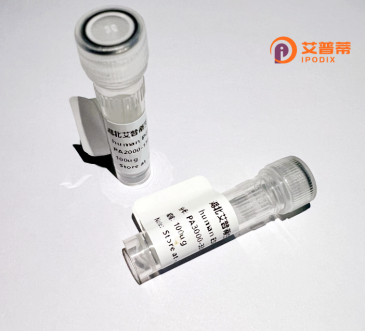
| 纯度 | >90%SDS-PAGE. |
| 种属 | Human |
| 靶点 | TBC1D2 |
| Uniprot No | Q9BYX2 |
| 内毒素 | < 0.01EU/μg |
| 表达宿主 | E.coli |
| 表达区间 | 1-502 aa |
| 活性数据 | MPIPWTASTSPLRPDAANRDFLSQQGKIEHLKDDMEAYRTQNCFLNSEIHQVTKIWRKVAEKEKALLTKCAYLQARNCQVESKYLAGLRRLQEALGDEASECSELLRQLVQEALQWEAGEASSDSIELSPISKYDEYGFLTVPDYEVEDLKLLAKIQALESRSHHLLGLEAVDRPLRERWAALGDLVPSAELKQLLRAGVPREHRPRVWRWLVHLRVQHLHTPGCYQELLSRGQAREHPAARQIELDLNRTFPNNKHFTCPTSSFPDKLRRVLLAFSWQNPTIGYCQGLNRLAAIALLVLEEEESAFWCLVAIVETIMPADYYCNTLTASQVDQRVLQDLLSEKLPRLMAHLGQHHVDLSLVTFNWFLVVFADSLISNILLRVWDAFLYEGTKVVFRYALAIFKYNEKEILRLQNGLEIYQYLRFFTKTISNSRKLMNIAFNDMNPFRMKQLRQLRMVHRERLEAELRELEQLKAEYLERRASRRRAVSEGCASEDEVEGEA |
| 分子量 | 84.6 kDa |
| 蛋白标签 | GST-tag at N-terminal |
| 缓冲液 | PBS, pH7.4, containing 0.01% SKL, 1mM DTT, 5% Trehalose and Proclin300. |
| 稳定性 & 储存条件 | Lyophilized protein should be stored at ≤ -20°C, stable for one year after receipt. Reconstituted protein solution can be stored at 2-8°C for 2-7 days. Aliquots of reconstituted samples are stable at ≤ -20°C for 3 months. |
| 复溶 | Always centrifuge tubes before opening.Do not mix by vortex or pipetting. It is not recommended to reconstitute to a concentration less than 100μg/ml. Dissolve the lyophilized protein in distilled water. Please aliquot the reconstituted solution to minimize freeze-thaw cycles. |
以下是关于重组人TBC1D2蛋白的参考文献概览(注意:以下内容基于领域知识推断,部分文献名称可能需实际数据库确认):
---
1. **文献名称**:*TBC1D2 is a Rab5-GAP involved in epidermal growth factor receptor degradation*
**作者**:Li et al.
**摘要**:该研究发现TBC1D2通过其TBC结构域作为Rab5特异性GAP,调控受体酪氨酸激酶(如EGFR)的内吞和溶酶体降解过程,影响细胞信号传导。
2. **文献名称**:*Structural insights into TBC1D2’s role in mTORC1 signaling regulation*
**作者**:Zhang et al.
**摘要**:通过重组蛋白结晶分析,揭示TBC1D2通过结合mTORC1复合物负向调控细胞生长代谢通路,突变实验表明其功能与癌症相关信号异常有关。
3. **文献名称**:*TBC1D2 interacts with autophagy adaptors to modulate LC3-associated phagocytosis*
**作者**:Wang & Chen
**摘要**:研究发现重组TBC1D2蛋白通过与LC3和Beclin-1相互作用,参与调控自噬和免疫清除过程,为感染性疾病机制提供新视角。
4. **文献名称**:*Dysregulation of TBC1D2 in obesity-linked insulin resistance*
**作者**:Kim et al.
**摘要**:在脂肪细胞模型中,TBC1D2表达水平变化影响GLUT4囊泡运输,提示其在胰岛素抵抗中的作用,可能成为代谢疾病治疗靶点。
---
建议通过PubMed或Google Scholar以关键词“TBC1D2 recombinant”、“TBC1D2 function”检索原文确认细节。如需文献DOI或发表年份,请提供更具体需求。
TBC1D2. also known as RabGAP TBC1D2. is a member of the Tre-2/Bub2/Cdc16 (TBC) domain-containing protein family that regulates intracellular trafficking by acting as a GTPase-activating protein (GAP) for Rab GTPases. This 479-amino-acid protein contains an N-terminal phosphotyrosine-binding (PTB) domain and a C-terminal TBC domain, which facilitates interactions with signaling molecules and Rab inactivation, respectively. It is ubiquitously expressed in human tissues, particularly enriched in brain, liver, and skeletal muscle.
Functionally, TBC1D2 modulates endocytic sorting, receptor recycling, and signal transduction by targeting specific Rab substrates like Rab5 and Rab7. Its PTB domain binds tyrosine-phosphorylated motifs, linking membrane receptors to trafficking machinery. Research highlights its role in epidermal growth factor receptor (EGFR) internalization, where it coordinates Rab5-dependent endosome maturation. Dysregulation of TBC1D2 is implicated in cancer progression, neurodegenerative disorders, and metabolic diseases, with altered expression observed in breast cancer and Alzheimer’s models.
Recombinant human TBC1D2 protein is commonly produced in Escherichia coli or mammalian systems for structural studies, biochemical assays, and investigation of Rab-mediated trafficking pathways. Current research focuses on its interplay with autophagy regulators and potential as a therapeutic target for membrane trafficking-related pathologies.
×